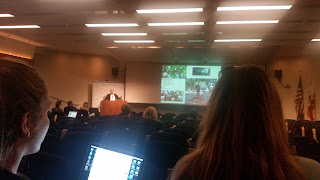Blogpost 5- BioTech and Art
Since the choices one makes, draw out their lives, life can be argued a an expressive medium. How one lives their life each day is up to them. Their body or life is an blank canvas and the actions are the paintings or drawings.
An example of biotech is the GFP Bunny, or fluorescent bunny. The bunny was in a sense created by Eduardo Kac, mixing different genes from other organisms to make the albino bunny light up if under the correct lighting. This is an example of transgenics. This “offers a concept of aesthetics that emphasize the social rather than the formal life” (Kac). They do things for the society and because it has an appealing look. This GFP bunny is unique in that Kuc created it as opposed to breeding the bunny a certain way.
| (Alba, the Fluorescent Bunny) |
Artistic technology is technology that looks appealing to the eye. For example, a human robot compared with a clunky looking robot. This technology should be valued for its purpose as well for its appealing look. If the technology looks nice, but has no use, who will buy it or give it another look? Artistic technology is evaluated differently as the look is also taken into effect. Scientists need to be artists and artists need to become scientists.
GMO’s, genetically modified organisms, are another form of biotech and art. This is where we have scientists manipulating organisms in order to create something that looks better and is cheaper. Some people are against it as they do not know what exactly they are eating and claim that it is unhealthy (Lallanilla). Others claim that foods with GMO’s are not as bad as they are cheaper than the alternative, organic, and are more resistant to pests. Personally, I do not mind GMO’s in foods as it is a lot cheaper.
| (GMO's) |
Artists should be given a little less restrictions using biotech than scientists in industry or academia. They are using their creativity to test something,so their guidelines should not be so rigid and should allow them to some freedom. Scientists, however, are testing out theories and they have to follow a rigid set of rules. Finally, to limit human creativity would be a crime. Without creativity, we are no longer individuals, but have now become robots. Without creativity, there would be no art or many inventions. Without creativity, we may still be cavemen today.
Sources
GFP Bunny. Alba, the Fluorescent Bunny. Photograph.
<http://www.ekac.org/gfpbunny.html#gfpbunnyanchor>
GMO Answers. Educational Resources. Photograph.
<https://gmoanswers.com/educational-resources>
Lallanilla, Marc. "GMOs: Facts About Genetically Modified Food." LiveScience. Purch, 11 Jan.
2016. Web. 14 May 2017
Linkedin. 5 Ways to Use Creativity in Corporate Reputation. Photograph.
<https://www.linkedin.com/pulse/5-ways-use-creativity-corporate-reputation>.
Kac, Eduardo. "GFP Bunny." GFP BUNNY. EKAC, n.d. Web. 13 May 2017.


Where do you think we should draw the line in terms of gene modifying? I understand what you are saying about how we have to let artists show their creativity, but is it worth the cost of harming our eco-system?
ReplyDeleteI agree that artists should be free to be creative, but limiting the guidelines as to what artists can and cannot do with respect to transgenics will create further ethical dilemmas. How do you feel about biotech in art from an ethical perspective? Or do you not care much, as you find the value in the art to outweigh any personal moral contradictions?
ReplyDelete